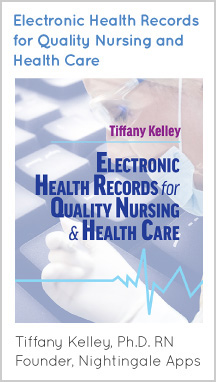Have you ever found yourself thinking ‘do I nurse the computer or nurse the patient?’ during your nursing shift? If the answer is yes, you are not alone. This phenomenon of ‘nursing the patient versus nursing the computer’ did not exist when I was a new nurse in 2000. This phenomenon emerged over the last decade as the nation has moved from a paper-based medical record system to the use of electronic health records (EHRs). However, unless you are a nurse (or health care professional) actively involved in providing direct patient care, this phenomenon may not be well known to you.
The phenomenon of nursing the patient versus nursing the computer is an internal struggle. The internal struggle is visible in the nurse’s behavior but not often verbalized by the nurse. As nurses, we are there to care for our patients. I have yet to meet a nurse who entered the profession because of their joy for charting. Instead, entering the profession often comes from the joy of caring for other people, our patients, during our shifts.
We, as nurses, know charting is part of our role and responsibilities. We learn this through nursing school courses, practicums and our preceptorship when first starting as a nurse in the health care organization. We respect the practice of charting, or documenting, on our patient. Yet, in many cases, the patient should be the priority over that of the chart. Thus, our instinct is often to care for the patient before caring for the patient’s record of information. However, there are times when this decision becomes a struggle for the nurse.
I witnessed this internal struggle many times during my doctoral research on understanding the information use of nurses before and after an electronic nursing documentation system implementation (). I noticed that nurses no longer consistently charted (e.g., documented) the patient assessment immediately after assessing the patient in the room the way they had when on paper flow sheets. Instead, nurses would assess each patient, and then, when a break in the day emerged to catch up on charting, the nurses would look for an available computer and proceed to batch chart. Batch charting, in this sense, is the act of entering data into the EHR for each assigned patient during an available interval of time, instead of in real time. Batch charting was not common nor a term I had used before until seeing this practice workaround emerge in the care settings.
Some of you reading this may wonder about the significance of this change in practice. The significance and as a result the internal struggle, presents when the patient needs the nurse and the nurse is in the middle of charting on the patient. The nurse may be in the middle of charting the patient’s assessment when a call light goes off. The nurse looks to the room and wonders what the patient might need. The nurse then looks at the computer screen. The nurse was hoping to be able to complete the assessment before a patient called for his/her nurse’s attention. If the nurse leaves the computer, he/she may not remember where he/she left off because there is no visual cue. Without knowing where he/she left off, the nurse may forget to chart something important on the patient’s care or a regulatory requirement that will emerge as a gap on chart audits. However, if the nurse stays and completes charting for the patient, he/she may be leaving the patient in pain, discomfort or some other unforeseen circumstance. Neither situation is desirable. Yet, the nurse must decide who (or what) will receive his/her attention.
Having observed and listened to nurses describe this struggle, the answer is not always as clear as it may be for those reading this post. Yes, the nurse should put the patient’s needs first. Yet, perhaps the patient needs something that the clinical assistant can help with or another nurse such as a glass of water or repositioning assistance. However, we cannot know the patient’s needs based on the call light alone. Additionally, we don’t always have a clinical assistant to help us or the availability of another nurse to check on the patient. When this happens every few hours of every shift, the internal struggle begins to compound on the nurse.
The compounding effect results in some feeling like data entry specialists or that they can’t provide the care that they want to for the patient or that they are always behind on charting and worried about the dreaded ‘if it isn’t documented, then it isn’t done’ feeling that nurses know all too well. I saw this and it was truly heartbreaking to see the struggle faced by nurses who simply want to care for their patients. I remember looking around and wondering why this wasn’t something that was visible to everyone. Regardless of the answer to that, we have to find a better way to support them in putting the patient first while continuing to communicate the patient’s care in the formal record for other nurses, doctors, and health care professionals to access for their own care decision making as well as for the patient.
I am not suggesting reverting to paper records. I am suggesting that we continue to take a close look at the workflow processes of how nurses use information to care for patients. This does not mean mapping out workflows in conference rooms but rather conducting observations and interviews with nurses to see what is happening in real time, hear their challenges and also uncover how we can help through new solutions. Had I not done paid close attention to the information behaviors of nurses, I wouldn’t have uncovered the need for Know My Patient.



